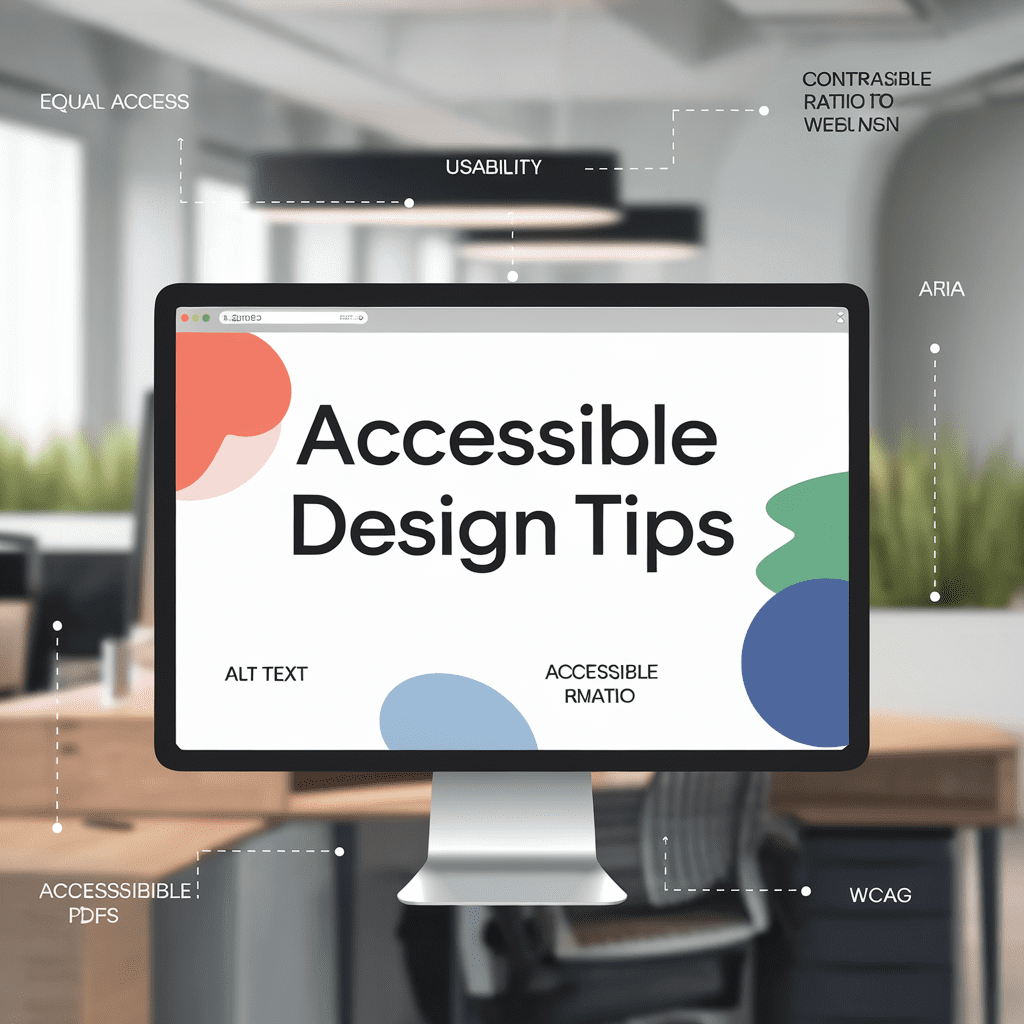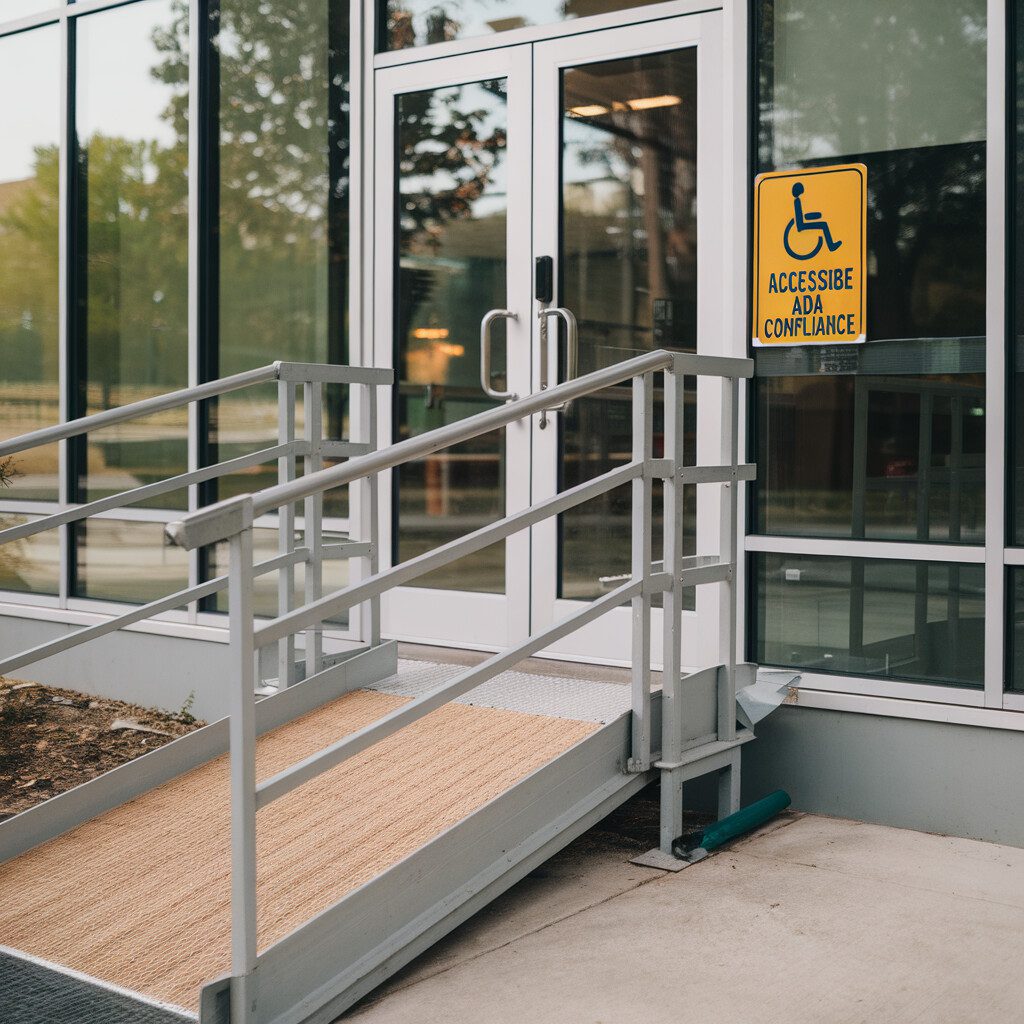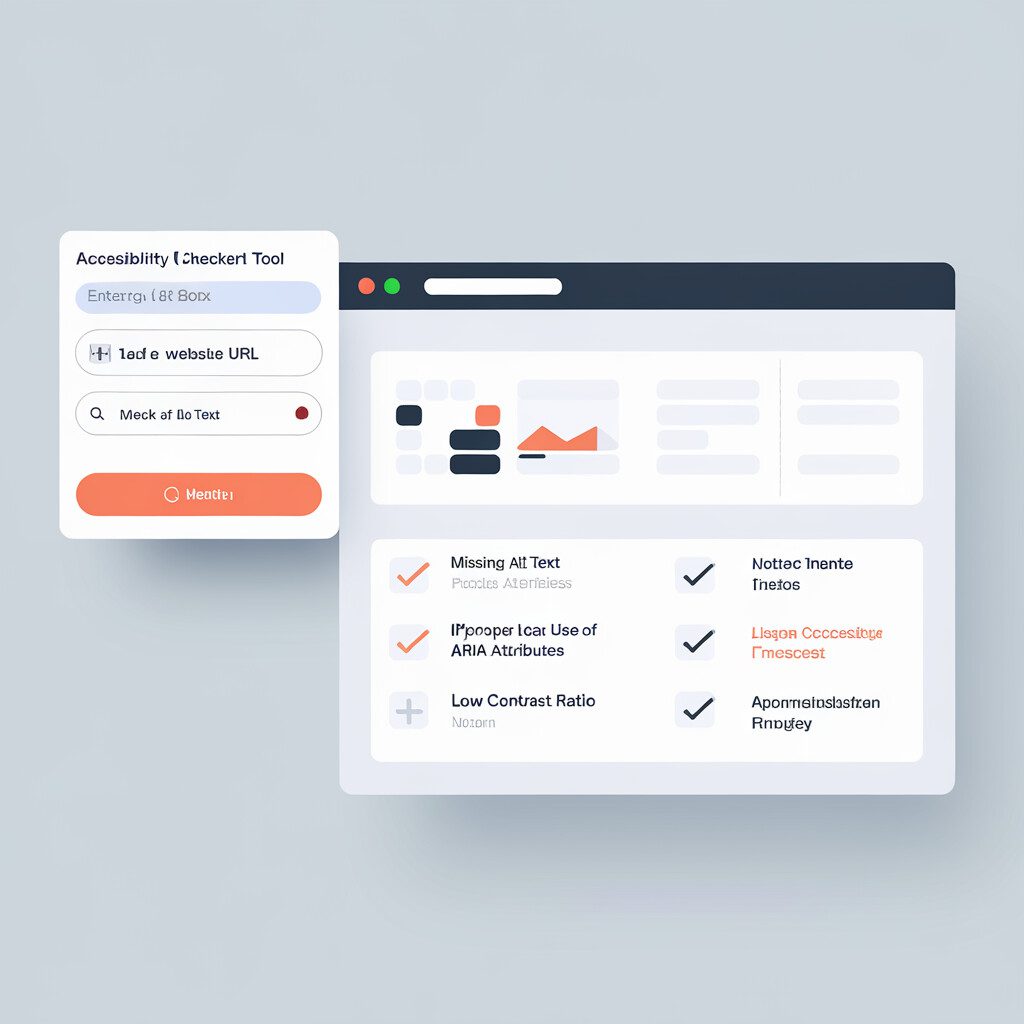
Hi there, fellow web accessibility enthusiast! We've all faced our fair share of roadblocks trying to create a platform that's easy for everyone to access, haven't we? Navigating the digital realm can feel like deciphering an elusive code. Lucky for you and me, our mutual dedication to creating a more inclusive internet has led us to the marvelous world of 'Accessible Design Tips.'
Does the phrase sound familiar? Should be—it's the latitude and longitude to our online accessibility quest. But how does one trace this map, you wonder? Sit back, my friend, as we reveal stories from the trenches, offer strategies tried and tested under fire, and share nuggets of wisdom gleaned from battle-hardened time spent on the front lines of website accessibility.
Every adventure through accessible design challenges brings about new revelations—the kind that warrants a 'Eureka!' much like Archimedes had in his bathtub. In our endeavor, we’ll deftly journey through the snag-filled terrains of barriers to accessibility but fear not! We're packing some ace-level strategies along.
Conversations about contrast ratio and HTML semantics might be technical for some – but for us; it's an invigorating dialogue! Weaving through these intricate trails understanding them can acquire the charm of decoding a Shakespeare sonnet or strategizing a complex Sudoku grid. Enthralling, isn’t it?
By journey's end we'll cherish, not just the treasure chests earmarked 'Successes,' but also the oft-overlooked ones marked 'Lessons Learnt.' Wiser from every misstep, we pour over results and measure our achievable impact—coding warriors returning from triumphant campaigns!
But hey, it’s not just solitary knight-errants we aim to be – more like builders of a welcoming community. So tune in as we catalogue how every line of accessible code we write fosters spaces that truly cherish diversity and inclusion.
Fair warning—the ride may get wild! But here’s a promise: no jargon-filled conundrums only straightforward simplicity, novel insights—maybe even laughter. Let's hold onto our hats, replace trepidation with curiosity, and explore this exhilarating dimension of 'Accessible Design Tips'—our very own digital accessibility renaissance. Ready for take-off?
Background: Understanding the Importance of Accessible Design Tips
When you first hear "accessible design," what does your mind wander to? Something far-fetched and tech galaxy far, far away? Well, you're not alone in feeling this way. Yet, let's open up the filters of perception a bit here. Under its cloak of complex technical terms like "ARIA" and "Contrast Ratio" breathing in its own niche within the universe of technology, accessible design brings you close to revamping the digital experience fundamentally. But why is this important?
You see, diving into this whirlpool of Accessible Design Tips can be viewed like that unexpected first bite of an exotic dish that turns out to have your favorite flavors. Suddenly, something earlier viewed as unpalatable becomes wholesome and intriguing!
Take, for instance, the story of John, the user-friendly tech whisperer in a modern-age startup. When tasked with upgrading his firm's website, he ended up stepping on legos-at least figuratively-spoonfeeding users instead of empowering them. The website included flashy elements but lacked alt text, which made it nightmarish for visually impaired users.
So instead of his website being a symphony orchestra where every instrument, like Accessible PDFs and Web Accessibility Initiative (WAI), plays a part in producing a magical composition, it became a tone-deaf ensemble leaving the audience scratching their heads.
But after incorporating Accessible Design Tips, John's firm witnessed an eruption of web traffic, fresh end-users from across the spectrum trickling in day by day. His website had transformed into an engaging and emancipating platform where everyone could interact freely. And finally, the user-friendly tech whisperer lived up to his name!
So why not plunge fearlessly into the world of accessible design? It's less coding cyborg talk and more like tearing down walls, encouraging equal access to that fickle online terrain, and building a digital community that maps every nook and cranny, transforming common inconveniences into charismatic feasibility. And hey, you never know what transformation sunny side it holds for you and your firm! Let's walk the path towards WCAG-compliant innovation while embracing our core values of community building, shall we?
This section just scratched the surface – continue with us to go deeper down the rabbit hole, there's a lot more intrigue awaiting!
Challenges Faced: Overcoming Barriers to Accessibility
Building on the insights shared earlier, let's explore how daunting hurdles can be tackled with the right dose of accessible design tips laced with technology. It's evident we live in an increasingly digitized world. However, let’s create a vortex for a moment—a big, buzzing whirl of thoughts—in our minds. How about plunging into the shoes of a visually impaired person attempting to view your favorite Netflix series? Pretty intimidating, isn't it? Now hold that thought!
Imagine a tech firm unveiling a user interface (UI). It’s flashy and intricate—yet for users with color blindness, it's a maze refusing to brick down. This illustrative case underlines a key barrier of accessibility or usability issues many overlook. Sniffing out these challenges infused the prompt initiation of Netcolors, an innovative app transforming solutions into reality.
Netcolors deployed substantial accessible design tips to develop an advanced color contrast algorithm for color-blind users. The app used technology like Accessible Rich Internet Applications (ARIA) and adhered to the guidelines mentioned in WCAG to make the user interface more accessible and easier to navigate. As simple as flipping through your grandmother's recipe album!
Moreover, it used "Alt Text" for every graphic element. Want another twist in the tale? NetColor’s site itself sported optimal contrast ratios. But they didn’t euphorically ring their victory bells just yet. To ensure that their steps were firmly grounded in usability and equal access land, they sought feedback from communities associated with visual impairments. An admirable example of community building, isn't it?
Absorbing these vital accessible design tips from Netcolors painted over factual challenges in achieving fully accessible digital spaces. Continuing our exploration, this real-life testament is sure to empower you as well to surf over the giant waves of accessibility barriers lurking at every website corner. So why not take a shot at embracing accessible design strategies? You might surprise yourself with what solutions you discover on your journey to a more inclusive digital universe.
Strategies Implemented: Implementing Effective Accessible Design Tips

Expanding the conversation around web accessibility, let's dive into an exciting world that not only breaks barriers but also makes technology a bit more human, shall we? Our case study is a reliable website that wanted to reach new heights in creating an equal access platform.
Intrigued by the concept of equality even in the virtual world, they took meaningful steps to integrate accessible design tips into their system. The main challenge was overcoming usability issues. Users familiar with keyboard navigation faced difficulties in smoothly accessing different features of the website.
What could turn these challenges into victories? Enter 'Accessible Rich Internet Applications' (ARIA). This collection of techniques and structures provided a practical roadmap for improving both the accessibility and usability of their content. Adding ARIA attributes to their HTML code like breadcrumbs on a trail made a marked difference in keyboard navigation. It was like providing a well-guided museum audioguiding to an enthusiast who is eager to decipher every color and stroke of the exhibited paintings.
Adding Alt Text to images was also a monumental enhancement for low vision users. Describing pictures like a sequence from an engaging graphic novel enabled them to visualize the message.
Moving forward, they harnessed established guidelines from WCAG to tweak contrast ratios ensuring that no two colors on their platform are ancestors from the same family tree. Moreover, visual elements were repurposed into accessible PDFs, catering delightfully to screen readers.
On an ending note, life is too short for inaccessible websites. Your move to sprinkle some accessible design tips could help tear down walls eons old! So why not take this beautiful narrative as an invitation to experiment and craft a digital space that offers a warm welcome to everyone? Remember, you're not just creating applications; you're building a community.
Results Achieved: Measuring the Impact of Accessible Design Tips
Continuing our exploration into the world of accessibility, let's dive headfirst into a case study that highlights how "accessible design tips" can make a sea of difference. Have you ever explored the contrast ratio on a website and noticed how it bettered your online experience? Well, get ready to jump into an example exhibiting just that.
Consider this scenario where a tech startup recognized default color contrasts on their site were, rather disappointingly, leading to problematic usability. To pinpoint the issue's crux, they conducted inclusive user tests empathizing with a diverse audience—blind or low-vision users and elderly people with deteriorating eyesight. Thorough analysis pointed towards a significant dip in website traffic due to these overlooked accessibility issues.
The troopers that they were, they didn’t just wring their hands and bemoan their issues. They went to work! Implementing practical accessible design tips, they corrected their contrast ratio aligning it with the much-regarded WCAG (Web Content Accessibility Guidelines). This alteration, small yet potent, made the text content legible to all users – elevating overall usability.
Witnessing the resulting analytical data was like hitting the jackpot in a tech-inspired lottery! After implementing these changes, they recorded a drastic uplift in the website traffic, phenomenal bounce rate reduction, and increased dwell time.
Who says small steps cannot lead to epic changes? This very case is hard evidence of how accessible design tricks hold the potential to totally revamp digital interactions between your website and users.
So why not give this fabulous approach a whirl? You might land up being your own success story! Echoing an ethos deeply ingrained within community building core values, remember – ""When one has access, we all prosper!""
Now packing wisdom from this practical example under our belt, buckle up—our journey isn't scheduled for a pit-stop anytime soon. Let’s step on the gas pedal as we accelerate into means of reaping the benefits of, what it appears to be, our magic potion—the incredible world of accessible design tips.
Lessons Learned: Key Takeaways for Future Accessibility Projects
Pivoting from the nuggets of wisdom we've mined so far, it's time to reflect on the key takeaways and lessons learned for future projects. You know, those life-changing "aha!" moments that transform the lens through which we look at accessibility in design. Well, let's dive into those insights, using "Accessible Design Tips" as our guiding star.
To paint a clearer picture, let’s consider an overarching theme from our case analysis—the need for inclusive usability. There was once a team, let’s call them “Team Adventurers”, who embarked on an ambitious journey to craft a groundbreaking website. Laden with flashy ARIA labels they thought would boost navigability, they were convinced they had it nailed.
Boy, were they in for a surprise! Initial feedback revealed floating ARIA regions that left visually impaired users flustered—like being caught in a digital minefield with no rhyme or reason. Yet adversity breeds adaptation, right? These harsh realities swiftly reshaped Team Adventurers’ perspective. Stripping back their initial approach, they honed in on “Accessible Design Tips”—focusing on minimalistic ARIA usage and clarifying the contrast ratio. And guess what? It transformed their stumble into a triumph.
Just as ALT text is the unseen hero that supplements image context for screen reader users, understanding accessibility or usability issues became Team Adventurers’ silent instrument of project victory. Navigating these turbulences also illuminated the importance of Accessible PDFs, offering another eye-opening experience—a reminder that the robust WCAG guidelines exist as a ready-made toolbox for all design adventurers out there.
So, after bouncing around in this real-life accessibility safari, what can we extract for our future missions? The mantra is simple but profound: User-first accessibility isn't a one-time event. Our travel bag should continually expand, valuable "Accessible Design Tips" added, not just at project onset, but as our journey evolves.
Inclusivity isn’t just about extending a hand but walking the path side by side, guiding and learning along the way. Let’s encourage barrier-breaking technology, fueled by the humanity anchoring our words to screens, bots to souls — All with one goal in view: Creating a vibrant, inclusive digital community that respects individual needs and experiences. Remember, folks, the essence of successful accessibility projects lies not in one-time achievements, but in sustained development and robust community building.
Alright, fellow futurists, why not pack up these gems we've discovered on our discovery tour into your strategy toolkit? You never know when they'll light your future paths to more accessible and engaging design projects.
Community Impact: How Accessible Design Tips Foster Community Building
Building on the insights shared earlier, let's dive into how accessible designs can knit communities tighter. Do you recall the times when we gathered around for a ‘community fair’ in our neighborhood? The shared laughter, experiences, an open forum to exchange ideas – it was all so enriching wasn’t it? Such warmth and inclusiveness need a replica in the online space as well, right?
Enter: Accessible Design Tips.
For instance, a renowned tech forum employed these Accessible Design Tips intending to stimulate community building. Indeed, they faced challenges with members who had accessibility or usability issues. Fret not! They rose to battle these hurdles using techniques like providing alternative text "alt text" descriptions for visual elements and ensuring sufficient contrast ratio for easy readability. As cool as a cucumber they were, wouldn't you agree?
Simultaneously, aiming at crafting easily navigable web design, they devised ARIA labels especially for users relying heavily on screen readers. Additionally, by adhering strictly to the WAI and WCAG guidelines, they even shaped their PDFs accessibly. Now, that’s creating an equal world for you folks, isn’t it?
With these modifications straight from the Accessible Design Tips recipe book, the forum witnessed not just an increase in traffic but also higher engagement rates. This ripple effect encouraged double-fold participation in ongoing community discussions, was far-reaching and largely successful.
So you see, colleagues, tech accessibility is more than compliance – it’s a giant leap towards an inclusive digital community. Peel this onion further and you’ll see how contributing to a culturally rich, mutually beneficial internet fellowship doesn't just increase traffic but also retains it, handing you in silver platter a loyal base of engagement. So friends, why not give these accessible design tips a whirl in your next project? The wonders of technology are all here to share the stage with you! Spread warm, joyful vibes into your community through an accessible tech interface, shall we?
Conclusion
Whoa! Now that's been quite an adventurous exploration into the vast world of accessible design tips, right? From the advent of our journey where we outlined the weighty importance of accessibility, down to the firsthand accounts of overcoming roadblocks – we've seen it all together. And guess what? We nailed it!
Challenges? Yeah. We bumped into quite a few. But just like a top-rated video game, aren't they the part that makes the experience really engaging? The real hero lies in using clever accessible design strategies to smash these pesky barriers – think of it as getting the golden key in a quest, yet so much more valuable.
What we've achieved speaks for itself, don't you think? Measurable impacts and strong practicality of our adopted tips just scream "success!". My granny would often say, nothing valuable comes without its fair share of trial and error, and she was spot-on! Our key takeaways and lessons learned are reminder of this.
Now, why just keep this treasure chest of insights to ourselves when they can act as beacons for others in a similar boat? Let's spread our victory dance far and wide. Remember, every application of an accessible tip waters the seedling of community building!
Why not leap into these insights, absorbing their power to harness for your own challenges, or even better, dig into other case studies in the same sector? Trust me; hitting the final 'game over' victory screen never felt so good – not even on my legendary hour-long retro game nights!
Heck yeah, diving into unfamiliar waters might seem touch and go at first. However, breaking down complex ideas into digestible nuggets is half the battle won (like eating an elephant! Not literally…sigh!). Trust your quirky strategist here: Once crackers about accessibility, always crackers about it!
So go ahead. Get out there and absorb these titbits in your world. Heck, jam them into every nook and corner of your obstacles. Leave none untouched! Let's take accessible design from muddling middle boss to grand-master level, like it deserves to be. Be the torchbearer lighting up new paths of accessible technology, making lives better, one golden accessibility tip at a time!
FAQ:
What are some practical strategies for improving web accessibility? Implementing accessible design begins with a commitment to continually educate oneself and put best practices into action. Several strategies highlighted in our case study proved effective. First, ensuring compatibility with assistive technologies like screen readers is crucial—alt text for images, descriptive link texts, and easy keyboard navigation being primary focuses. Second, content must be understandable and intuitive—lang attribute and clear site structure contribute to this. Finally, testing with actual users possessing various disabilities reiterated the incremental improvement philosophy: rather than striving for immediate perfection, value lies in each step toward greater accessibility. Why is community building emphasized in this case study on accessible design? The case study highlights how improvements in web accessibility don't exist in a vacuum—they have significant broader social implications. Better accessible design benefits not only individuals with disabilities but also contributes to more comprehensive community inclusion. On a more interactive platform, users of disparate abilities can engage with content, contribute their perspectives, and participate equally. Democratizing access to digital content fosters a diverse, rich community that values and promotes inclusivity—an outcome consistent with the underlying ethos of the web itself.


